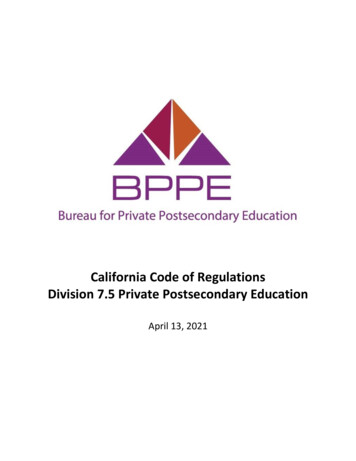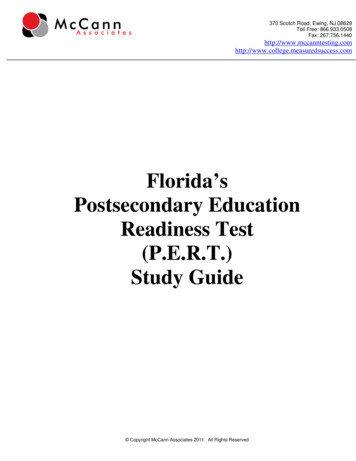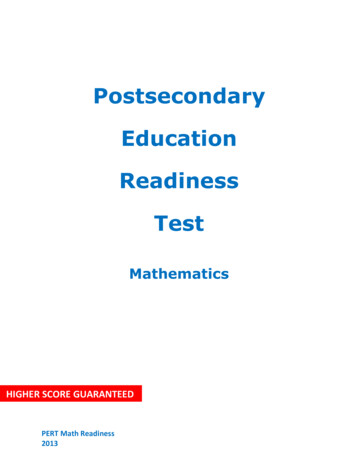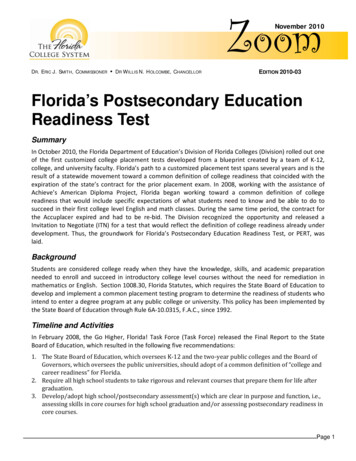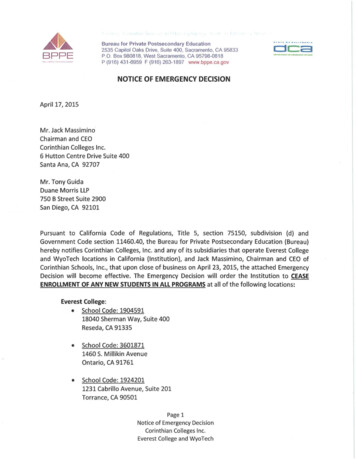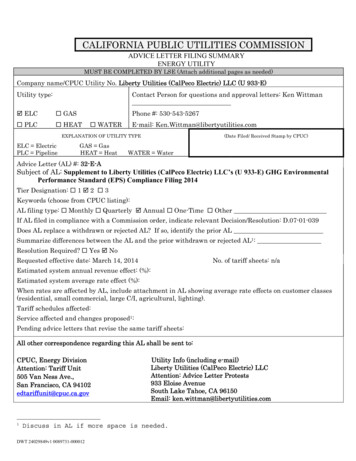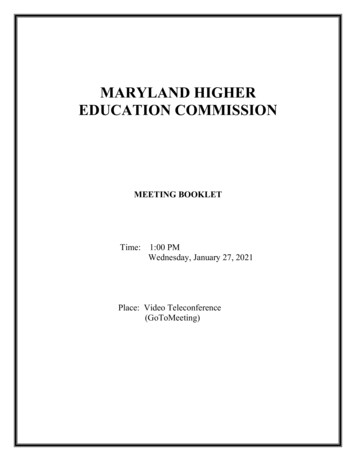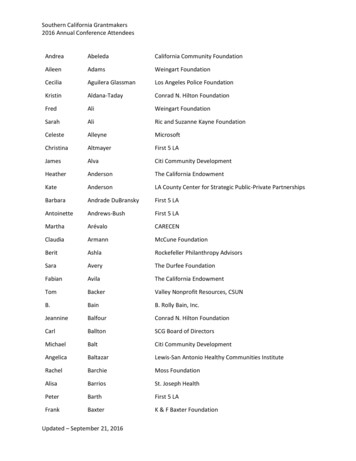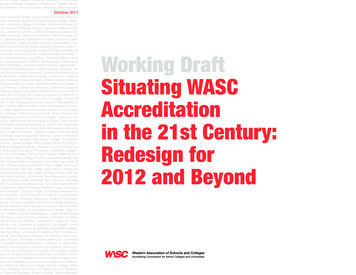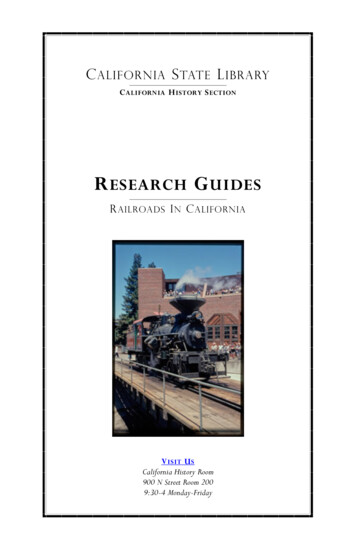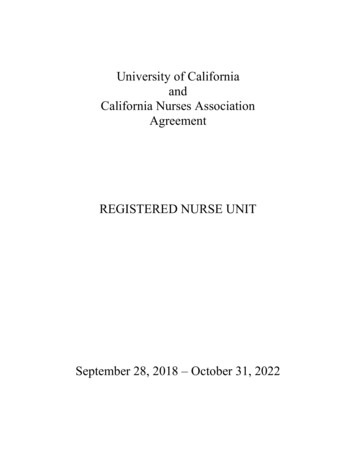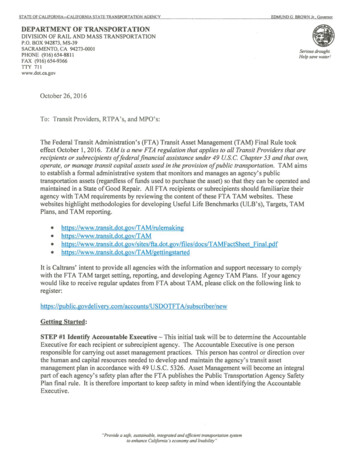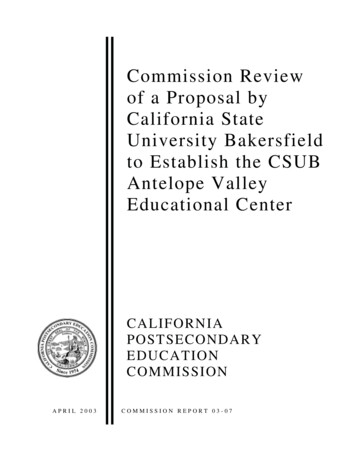
Transcription
Commission Reviewof a Proposal byCalifornia StateUniversity Bakersfieldto Establish the CSUBAntelope ValleyEducational RIL 2003COMMISSION REPORT 03-07
SummaryThis report reviews a proposal by the California State University Board of Trustees and California State University, Bakersfield, to establish a permanent Stated-approved education center in Antelope Valley. The proposed center would be namedthe CSU Bakersfield Antelope Valley Education Center, and itwould serve the growing populations of northern Los AngelesCounty and unincorporated areas of south-central Kern County.California State University, Bakersfield (CSUB), has operatedan off-campus center in the Antelope Valley since the late1980s.In 1996, the center moved to leased quarters situated on theAntelope Valley community college campus, where enrollmentgrowth has been phenomenal. As of academic year 2001-02,more than 800 students were enrolled in upper-division coursesand education credential programs at the center. The 544 Fulltime Equivalent Student (FTES) enrollment now exceeds the500 FTES minimum enrollment threshold required for Stateapproved center status. State University planners anticipatethat FTES enrollments will increase by about 52 percent between academic year 2001 and year 2012, or by 417 additionalFTE students. By achieving State-approved status, the centerwould become eligible to compete for State capital outlay andsupport budget funding.The Commission approved this report at its meeting on April 8,2003. It has been be added to the Commission’s Internet website -- www.cpec.ca.gov -- and will be electronically accessibleto the general public.Additional copies of this and other Commission reports mayalso be obtained by e-mail at PublicationRequest@cpec.ca.gov;or by writing the Commission at 1303 J Street, Suite 500, Sacramento, Ca. 95814-2938; or by telephone at (916) 322-9268.
ContentsPageSection1ONE Background to the Proposal1Introduction1Statutory and Administrative Requirements3Origins of the Proposal Under Review5TWO Proposal Findings andRecommendations5Unique Review Circumstances of the Current Proposal6Recommendation6Enrollment Projections7Alternatives8Academic Planning and Program Justification9Student Services and Outreach9Support and Capital Outlay Budget Projections10Geographic and Physical Accessibility11Effects on Other Institutions13AppendicesAppendix A: Guidelines for Review of Proposed UniversityCampuses, Community Colleges, and Educational Joint-UseCenters
DisplaysPageDisplay21Southern California and the Antelope Valley Region with 2000 CensusPopulation Distribution72Actual and Projected Enrollment Demand for the Antelope ValleyCenter, 1997 to 2010, by Class Level83Academic Programs and Disciplines offered at the CSU BakersfieldAntelope Valley Center104Travel Distance and Times from the Antelope Valley Region to theCSU Bakersfield Antelope Valley Center
1IntroductionBackground to the ProposalIn this report, the Commission considers a proposal by the CaliforniaState University Board of Trustees and California State University, Bakersfield to establish a permanent Stated-approved education center inAntelope Valley. The proposed center would be named the CSU Bakersfield Antelope Valley Education Center, and it would serve the growingpopulations of northern Los Angeles County and unincorporated areas ofsouth-central Kern County. The dot-density map shown in Display 1 provides a geographic representation of the population centers of the Antelope Valley.California State University, Bakersfield (CSUB), has operated an offcampus center in the Antelope Valley since the late 1980s. In 1996, thecenter moved to leased quarters situated on the Antelope Valley community college campus. Its current facilities include four modular buildingsand joint-use classrooms that are made available by Antelope Valley College and local high schools as needed by the center. By achieving Stateapproved status, the center would become eligible to compete for Statecapital outlay and support budget funding to accommodate new studentenrollment demand.Enrollment growth at the center has been phenomenal since it opened atits present location with an initial class of 24 post-baccalaureate studentspursuing credential programs in education. As of the academic year 200102, more than 800 students were enrolled in upper-division courses andeducation credential programs at the center. The 544 Full-time Equivalent Student (FTES) enrollment now exceeds the 500 FTES minimumenrollment threshold required for State-approved center status. Annualpercentage increases in student enrollments have averaged over 50 percent for the past three years, and State University planners anticipate thatFTES enrollments will increase by about 52 percent between academicyear 2001 and year 2012, or by 417 additional FTE students.Statutory andadministrativerequirementsThe State of California requires that new public institutions of highereducation be reviewed by the California Postsecondary Education Commission prior to their establishment. A central purpose of the State’s review process is to help ensure that new public colleges, universities, andcampus centers develop in accordance with broad statewide needs andpriorities, and that capital outlay funds are spent wisely. Specifically withrespect to the California State University, Section 89002 of the CaliforniaEducation Code expresses the intent of the Legislature that constructionof authorized CSU campuses and off-campus centers will commence onlyupon resolution of the CSU trustees and approval by the California Postsecondary Education Commission. Commission.1
Display 1. Southern California and the Antelope Valley Region with 2000 CensusPopulation Distribution2
The guidelines used by the Commission in reviewing proposals for newcampuses and education centers are presented in Appendix A. They provide campus planners and executives with a framework for planning newinstitutions and for developing proposals that require Commission review.Origins of theproposal underreviewFrom the outset in 1996, CSU Bakersfield has sought to create and buildon a cooperative and collegial partnership with Antelope Valley College.In many respects, the highly successful relationship can be viewed as thevade mecum for institutions interested in establishing intersegmental collaborations and joint-use facility arrangements. Notable cost-effectivearrangements include (1) a negotiated ten-year ground and security leaseat a nominal cost to the center to accommodate four modular buildings,(2) a qualified pool of on-site community college instructors that could beemployed as adjunct faculty members by the center when needed, and (3)instructional classrooms and laboratories that are made available to thecenter by Antelope Valley College and local high schools. The relationship has also helped the center develop formal course articulation agreements to assist Antelope Valley community college students who wish totransition to the center as under division transfer students.Over the past seven years, CSU Bakersfield has gradually expanded program offerings at the center from an initial set of education credentialprograms to baccalaureate program offerings in liberal studies, English,criminal justice, economics, psychology, communications, sociology, andnursing. All baccalaureate programs have been approved by the WesternAssociation of Schools and Colleges’ Substantive Change and OffCampus Program Committee. In addition to the undergraduate programs,the center also offers a master’s degree in education and various credential programs, including, a multiple subjects credential, a special education credential, and a secondary education credential. The Commissionon Teacher Credentialing approved the credential programs as part of areaccredidation visit to the main campus.The popularity of program offerings, coupled with strong regional population growth, has led to a tremendous surge in center enrollments at boththe undergraduate and post-baccalaureate levels. Total Fall enrollmentshave increased from 28 students in 1997 to 794 students in 2001. Asmentioned, State University planners anticipate that FTES enrollmentswill increase by about 52 percent between academic year 2001 and year2012, representing 417 additional FTE students.CSU officials have acknowledged, regrettably, that it is unlikely that Antelope Valley College would be able to provide a permanent site on itscampus for the proposed CSUB Antelope Valley Education Center. Italso is unlikely that the community college will be able to lease additionalland to the center to accommodate the center’s projected enrollmentgrowth. There is, however, room to accommodate one additional modular building. Given such constraints, Phase I of expansion reflects asteady-state of affairs wherein instruction would continue to be provided3
primarily in modular buildings, and augmented, to the greatest extentpossible, with classroom space borrowed from the community collegeand local public schools.State University planners intend to initiate Phase II of expansion if theCommission concurs with the recommendation to grant the center permanent State-approved status. Strategic planning objectives would includeaccommodating near-term enrollment growth by adding one additionalmodular building on the Antelope Valley College campus and leasing appropriate commercial space in the city of Lancaster. With the aid ofcommunity leaders, CSU Bakersfield would begin the process of identifying alternative sites to build a permanent center. To relieve some of theenrollment capacity pressures, the center intends to identify and considervarious course-scheduling arrangements that might help boost the proportion of total FTES generated by distance/distributed education from a current level of 11 percent to 20 percent by year 2007.Phase III of development, which is not part of the time horizon and planning framework of the current proposal, would entail selecting a preferredpermanent site, determining site acquisition costs and capital outlay funding needs, and initiating relevant environmental impact studies.4
2Unique reviewcircumstances ofthe currentproposalProposal Findingsand RecommendationsThe Commission’s Guidelines impose a number of requirements on governing boards that propose to establish new institutions of higher education, or that seek official recognition of existing facilities. The guidelinesinclude ten criteria under which all proposals for official education centerstatus are assessed. They are applied somewhat flexibly because of thevarying institutional circumstances involved.The present proposal of the California State University Board of Trusteesand California State University, Bakersfield, required the Commission toinitiate a modified review process because of the rather unique nature ofthe proposal. Typically, proposals for expanding or establishing educational centers come to the attention of the Commission only when there isa definitive long-range plan that includes, among other planning elements, (a) identification of an actual preferred site, (b) cost estimates forsite acquisition, (c) a detailed discussion of capital outlay budget needs,and (d) a comprehensive environmental impact report. It must be stressedthat costs associated with acquiring or constructing a facility, as well asthe appropriateness of the site and the size of the facility for the programsto be offered, are critical components that the Commission must evaluateand appraise prior to forming recommendations and conclusions with respect to any given proposal.Although it has been acknowledged that a new facility will be needed inorder for the CSU Bakersfield Center to accommodate enrollment demand growth, the planning horizon of the current proposal only coversPhase I and II of project expansion. During the early stages of development, as mentioned in the previous chapter, the center intends to meetenrollment growth principally by adding one additional modular buildingon the Antelope Valley College campus and leasing appropriate commercial space in the city of Lancaster. Upon a favorable review by the Commission, center officials state that they would began a long-range planning process that would include assessing the feasibility of acquiring apreferred permanent site, determining site acquisition costs and capitaloutlay funding needs, and overseeing relevant environmental impact studies.The Commission has determined that its conclusions and recommendations regarding the current proposal must necessarily be limited to theplanning horizon covering Phase I and II. To comment at this time on thelong-term need for a CSU Bakersfield Antelope Valley Education Centerbefore a long-term Needs Study and supporting documents have been put5
forth might set an undesirable precedent. Moreover, the California Legislature may very well interpret such an action as an abrogation of theCommission’s long-range planning responsibility of ensuring that offcampus centers develop in accordance with broad statewide needs andpriorities and that capital outlay funds are spent wisely.Accordingly, the following recommendation is made with the understanding that if the State University Board of Trustees and California StateUniversity, Bakersfield determine at a later time to establish an alternatesite for the proposed center, a new Needs Study must be submitted to theCommission for review under the same terms as required for the presentproposal.RecommendationContingent upon the Department of Finances’ approval of the enrollmentdemand projections contained in the proposal, the Commission recommends that the CSU Bakersfield Antelope Valley Education Center beapproved as a permanent CSU off-campus education center and becomeeligible immediately to compete for State capital outlay and supportbudget funding. It is understood that if an alternate permanent site isidentified subsequently for the education center, a new Needs Study willbe submitted to the Commission for review under the same terms asrequired for the present proposal.The recommendation is based on a careful analysis of the planning objectives and identified needs covering Phase I and II of project development.The remainder of this chapter provides a summary of findings in relationto the Commission’s review guidelines.EnrollmentprojectionsStatewide enrollment for the CSU should exceed the planned enrollmentcapacity of the existing campuses or compelling regional needs must bedemonstrated.The Commission’s recent regional enrollment demand study indicatedthat in the Los Angeles County Region, alone, there will likely be a needto increase the physical capacity of existing CSU campuses to accommodate an additional 23,000 FTE students by year 2010. The CSU AntelopeValley Education Center is expected to help relieve capacity pressures ofthe region as a whole, while providing more direct educational access tothe Antelope Valley area, where residents of the cities of Lancaster andPalmdale are located quite remotely from CSU Northridge, the nearestCSU campus.Enrollment growth at the center has been quite substantial since it openedat its present location with an initial class of 24 postbaccalaureate students pursuing credential programs in education. As of the academic year2001-02, more than 800 students were enrolled in upper-division coursesand education credential programs at the center. The 544 Full-timeEquivalent Student (FTES) enrollment now exceeds the 500 FTES minimum enrollment threshold required for State-approved center status. An6
nual percentage increases in student enrollments have averaged over 50percent for the past three years, and State University planners anticipatethat FTES enrollments will increase by about 52 percent between academic year 2001 and year 2012, or by 417 additional FTE students. Asshown by Display 2, enrollment demand is expected to remain strong atboth the undergraduate and postbaccalaureate levels.In addition to the population component of enrollment demand, CSUplanners attribute part of the rapid increase in enrollments at the center towhat it refers to as a market penetration effect. With respect to highereducation, the effect signifies the extent to which local residents are mobilized by an educational opportunity provided by an educational entityrelatively new to the region. Over time, of course, the effect will becomeless substantial as the pent-up demand is satisfied, as shown by the outyears in Display 2.DISPLAY 2Actual and Projected Enrollment Demand for the Antelope ValleyCenter, 1997 to 2010, by Class Level1,000Postgrads900FTE Fall TermAlternativesA cost-benefit analysis, including consideration of alternative sites for thenew institution, must be articulated and documented. This criterion maybe satisfied by the Environmental Impact Report, provided it contains acomprehensive analysis of the advantages and disadvantages of alternative sites. Overall, the system proposing the new institution must demonstrate substantial analytical integrity with regard to the site selectionprocess.7
Over the next ten years, there is little doubt that the most practical optionfor the center is to continue to lease space on the campus of AntelopeValley College. As noted earlier, cost-effective arrangements that havebeen put in place include (1) a negotiated ten-year ground and securitylease at a nominal cost to the center to accommodate four modular buildings, (2) a qualified pool of on-site community college instructors thatcould be employed as adjunct faculty members by the center whenneeded, and (3) instructional classrooms and laboratories that are madeavailable to the center by Antelope Valley College and local high schools.The present location has also made it more convenient for officials of thecenter and Antelope Valley College to work collaboratively in developingformal course articulation agreements to assist Antelope Valley community college students who wish to transition to the center as under divisiontransfer students.The present proposal did not contain an environmental impact report because the planning horizon covered just the near-term period wherein thecenter intends to accommodate enrollment growth principally by addingone additional modular building on the Antelope Valley College campusand leasing appropriate commercial space in the city of Lancaster.Academicplanning andprogramjustificationA preliminary description of the proposed academic degree programsmust be included, along with a description of the center’s proposed academic organization. The description must demonstrate conformity withsuch State goals as access, quality, inter-segmental cooperation, and diversification of students, faculty, administration, and staff.DISPLAY 3Academic Programs and Disciplines offered at the CSU BakersfieldAntelope Valley CenterAcademic ProgramGeneral Discipline AreaUndergraduateLiberal StudiesEnglishCriminal ursingPostbaccalaureateEducationMultiple Subjects CredentialSpecial Education CredentialSecondary Education Credential8Social ScienceHumanitiesSocial ScienceSocial ScienceBehavioral ScienceHumanitiesSocial ScienceBiological lied/ProfessionalApplied/Professional
The center has elected to offer quality programs in a select number ofacademic areas, as shown in Display 3. The general disciple areas comprising those programs are quite comprehensive in that they include thesocial sciences, biological sciences, behavioral sciences, humanities, andapplied professional. The CSU reports that the program offerings wereselected with significant input from Antelope Valley employers, community leaders, and educators. The
1 Statutory and Administrative Requirements 3 Origins of the Proposal Under Review 5 TWO Proposal Findings and . California State University, Bakersfield (CSUB), has operated an off-campus center in the Antelope Valley since the late 1980s. In 1996, the . nursing. All
